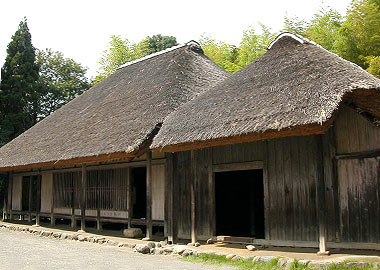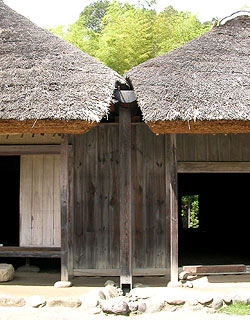| Lit. divided-ridge style. Often abbreviated to
buntou 分棟 and sometimes referred to as betsumune-zukuri 別棟造.
A widely used generic term for a range of vernacular residences *minka
民家, in which the unfloored service area *doma
土間, and the raised-floor suite of living rooms, kyoshitsubu 居室部, are contained
in different buildings called kyoshitsutou 居室棟 and domatou 土間棟,
respectively. These structures are either placed contiguously, or are set at the
most one or two meters apart and linked by a short passage *rouka
廊下 or pentroof *hisashi
廂, so that internally they function as a single house. Buntougata houses
are found in various districts: their northern limit is Miyagi prefecture, where
there are both farmhouses and military class residences, buke yashiki 武家屋敷 (see *buke-zukuri 武家造),
of this type. Further south, there is another cluster of buntougata farmhouses
in Ibaraki and Chiba prefectures, and another in western Shizuoka and Aichi prefectures,
where they are termed *kamayadate
釜屋建て. The greatest numerical concentration of buntougata and buntougata-derivative
houses, and the widest variety of types, are found in Kyuushuu 九州 the S.W. islands
of Kagoshima, and Okinawa prefectures. Buntougata houses have a range of
juxtapositions of the two main constituent structures. The most widespread is
a T-plan arrangement with a living suite and a service building flanking it, which
is typical of examples in the Kantou 関東 region and Aichi prefecture and common in Satsuma
薩摩 (now Kagoshima prefecture). Other arrangements include ranges abutted gable-to-gable (found in Miyagi
prefecture), and ranges placed side-by-side with their roofs parallel (found in
Kumamoto and Saga prefectures). The character of the link between the service and
living structures also varies: on the S.W. islands there are simple examples in
which the two elements are completely freestanding, while in Satsuma and Awa 安房
(Chiba prefecture), a short linking structure (called a tenoma 樋の間 in Satsuma)
is most common. In Aichi, Ibaraki, and north Chiba the two structures are tangential
with a large internal valley-gutter, uchitoi 内樋, running between them,
so that there is no dividing gap and the internal spatial continuum is barely
distinguishable from that of non-buntougata house. In Kagoshima, Okinawa
and Miyagi prefectures, it is common for the service structure to incorporate a floored area
or room, often equipped with an open hearth *irori
囲炉裏, whereas in other regions it is usually all earthen floored. |




